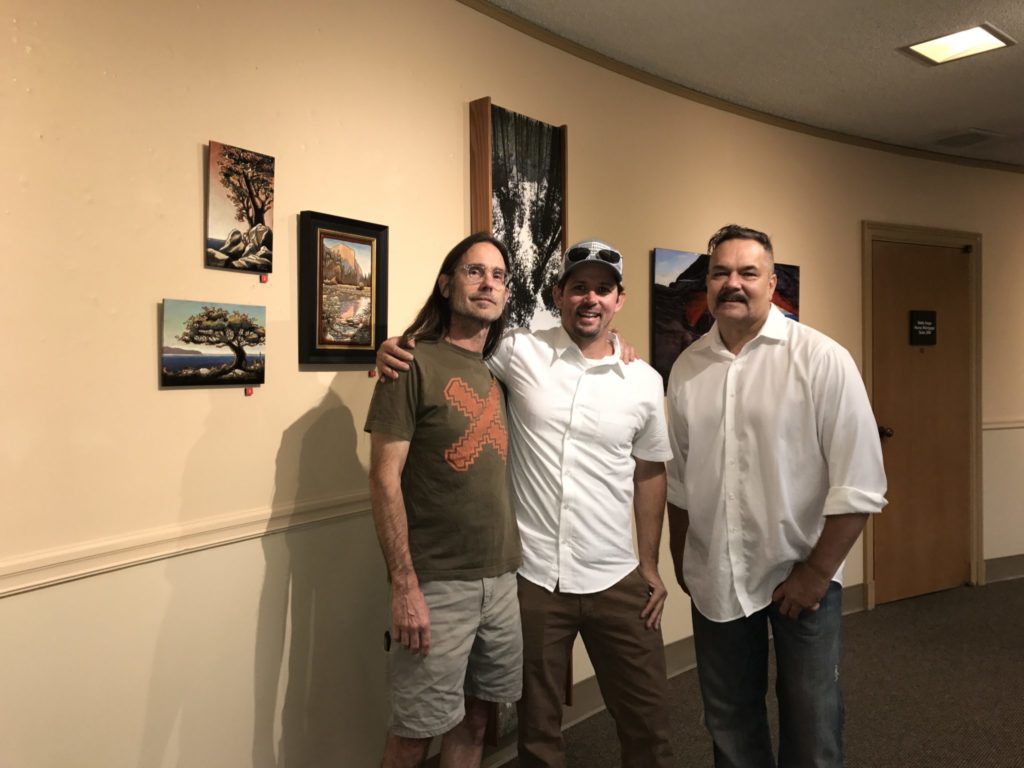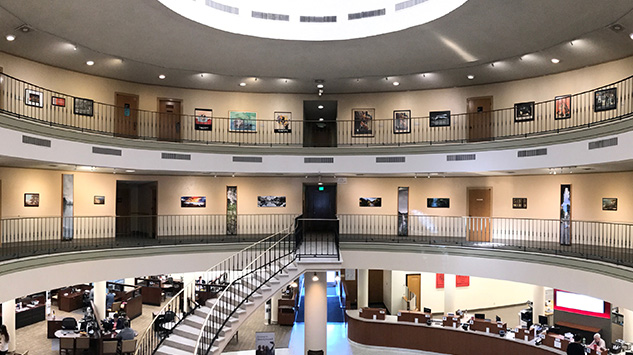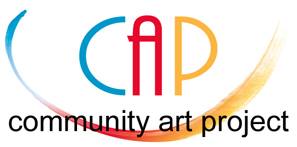Published in Stu News Laguna on December 12, 2017
By M. “Charlie” Ferrazzi
 At the recent Artists Talk on Image Makers in The CAP Gallery, Tom Lamb served as moderator. Tom, well known for his aerial, landscape, ethnographical and interpretive photographs, was an excellent choice. Using the term “image makers” to describe the three artists, and how they view and treat the landscape to tell their stories, Tom gave a brief introduction for each of the artists.
At the recent Artists Talk on Image Makers in The CAP Gallery, Tom Lamb served as moderator. Tom, well known for his aerial, landscape, ethnographical and interpretive photographs, was an excellent choice. Using the term “image makers” to describe the three artists, and how they view and treat the landscape to tell their stories, Tom gave a brief introduction for each of the artists.
Three different “image makers”: three different aspects.
Cheyne Walls searches for locations and subjects to explore and share. Looking for the perfect time, be it season of the year or hour of the day, when Nature is at her best.
Mike Tauber looks for painterly landscapes to interpret the values, hues, colors, the shadow and light play, texture and feeling of the scene onto ceramic tile works.
Troy Poeschl works in two different mediums; photography and sculpture. Shapes, structure, texture, light, shadow and material all play parts in his work.
How did growing up in California affect your lives?
Cheyne Walls grew up in Dana Point. Time spent outdoors at beaches, deserts and mountains made him aware of being able to see the most incredible sights everywhere he went, areas of Nature still untouched and wild just a short travel time from where he lived. Knowing these areas exist motivates Cheyne to go and find more to explore.
Mike Tauber came from Illinois to attend college. For Mike, the California climate is much more conducive to spending time outdoors exploring on a year-round basis. Catalina, the desert and more are so close and accessible at any time. Always on the lookout for landscape sights that are close to a completed composition with little editing, Mike explores wherever he goes.
Troy Poeschl grew up in Orange. His family enjoyed camping, and when not camping Troy was always outdoors. Yosemite is a frequent place he has explored and is still exploring. It is Nature and how it is constantly changing that stimulates his creativity.
Are there any artists who influence you and your work?
For Tauber there is no particular artist. Pulling from the Classic and Traditional schools, he looks to the California Plein Air movement for his palette of colors. Vintage advertising art, postcards and packing crate labels promoting an optimistic and vibrant life from the glow of the colors. Travel ads promoting health and beauty with a “Come to California” attitude. These are elements that enliven Tauber’s imagination and his urge to create.
Ansel Adams is an artist that inspires Walls. Adams’ black and white works caused Walls to look at his subject and see that sometimes more can be shown in a black and white image than a color one, by accentuating shape, form, texture and light.
The new advancements in technology is another aspect that pushes Walls’ creativity. Being able to manipulate an image in the lens, capturing what he sees at the moment he shoots, enriches his images letting him share what he visually experiences at that time and place.
Nature is what inspires Poeschl’s art, not a particular artist. Color, texture, shape, shadow, movement, change, exploration of an area, or a material, and the challenge of how to bring it into a completed work of art is a driving force for Poeschl and his work.
What methods do you employ in creating your art?
 The view can determine the shape of the finished image. After finding his subject area, Walls visits several times to find the best time and light for his composition. He also decides whether to shoot black and white or color. The ability to capture sharper images, bring elements to more prominence or push them back, similar to how the eye sees them, are all parts of his creative process.
The view can determine the shape of the finished image. After finding his subject area, Walls visits several times to find the best time and light for his composition. He also decides whether to shoot black and white or color. The ability to capture sharper images, bring elements to more prominence or push them back, similar to how the eye sees them, are all parts of his creative process.
Using a panorama technique to get his view, he can swap out lenses to get exactly what he wants to be the focus of his shot. Long exposures, lens filters, camera settings, detailed editing and in-depth printing, are parts of producing the natural beauty that exists at the time that Walls is shooting.
A majority of Tauber’s work is site specific and commissioned. This means that he is working with someone, in the design process, to create the finished piece. The challenge of using outside information and creating the finished piece is something Tauber enjoys.
Starting with blank terra cotta tiles from Italy, Tauber draws his design in pencil. Next he goes over the drawn lines with a brown colored wax, creating wells for the glazes to fill. Painting the glazes into the areas, he may apply a thick layer to give it texture and allow different colors to meld together to create interest. He may mix glazes to enrich and give the finished tile the look of a plein air brushwork painting.
Baked in a kiln one to two times, the finished piece is ready for installation. Large works are done with multiple tiles in a grid pattern, giving the feeling of looking out a window to see the view.
Poeschl literally bends over backwards for his art
Poeschl starts out with sketching shapes for his sculpture works: How best to present the material to show its uniqueness and beauty. What other possible materials can be used to not just enhance the main material, but to also expand the overall design and feeling of the finished work.
In Poeschl’s photography work, finding a unique and introspective location is the starting point. Pure colour is important along with the texture, light and shadow and shapes. There is also the intangible side of his photographs, the mood and atmosphere of the place he is at when photographing. All are part and parcel of communicating with the viewer.
Currently working with panorama perspective, Poeschl produces vertical as well as the usual horizontal scenes. Starting at the bottom and moving the eyes up the photograph, the viewer is given the feeling of being in the location front and back, in his vertical works. To accomplish this, Poeschl truly does bend over backwards.
Where do you go from here?
“I can’t see being anything else but a photographer,” Walls responded to this question. Having been involved with photography since college when he was sidelined by an injury in sports, it has been the focus of his world.
The freedom to go out and observe and experience Nature, then to share those perfect moments in time with others is one of the things that keeps Walls shooting. Another is to excite others to go and see it for themselves, not just appreciate the artistic merit of the work.
Tauber will continue in Art with his tile work but is looking towards expanding into larger projects that may take a year or two to complete. He would like working in a bigger scale than his current works, with an eye to mural work and large public works.
“Art is in my blood,” Tauber quipped.
Poeschl is pushing to combine works into more 3-D scaled projects. Being a sculptor along with a photographer, to combine the two mediums seems to be a logical move in his mind’s eye.
About CAP – Community Art Project
 CAP’s mission is to increase the visibility and appreciation of Art and serve as a catalyst for Art Education. CAP provides ongoing exhibition in The CAP Gallery, Banking on Art in the Rotunda Gallery space located on the second floor of the Wells Fargo Building, 260 Ocean Avenue.
CAP’s mission is to increase the visibility and appreciation of Art and serve as a catalyst for Art Education. CAP provides ongoing exhibition in The CAP Gallery, Banking on Art in the Rotunda Gallery space located on the second floor of the Wells Fargo Building, 260 Ocean Avenue.
The CAP Gallery is a unique space for juried, solo and retrospective exhibitions. Visit www.caplaguna.org for information about ongoing or upcoming exhibits, to be on our e-mail list or to become a member and supporter of CAP. CAP is a 501(c)(3) non-profit funded by the member supporters, the lodging establishments and the City of Laguna Beach. Admission is free to this exhibit, which runs until Jan 30.

